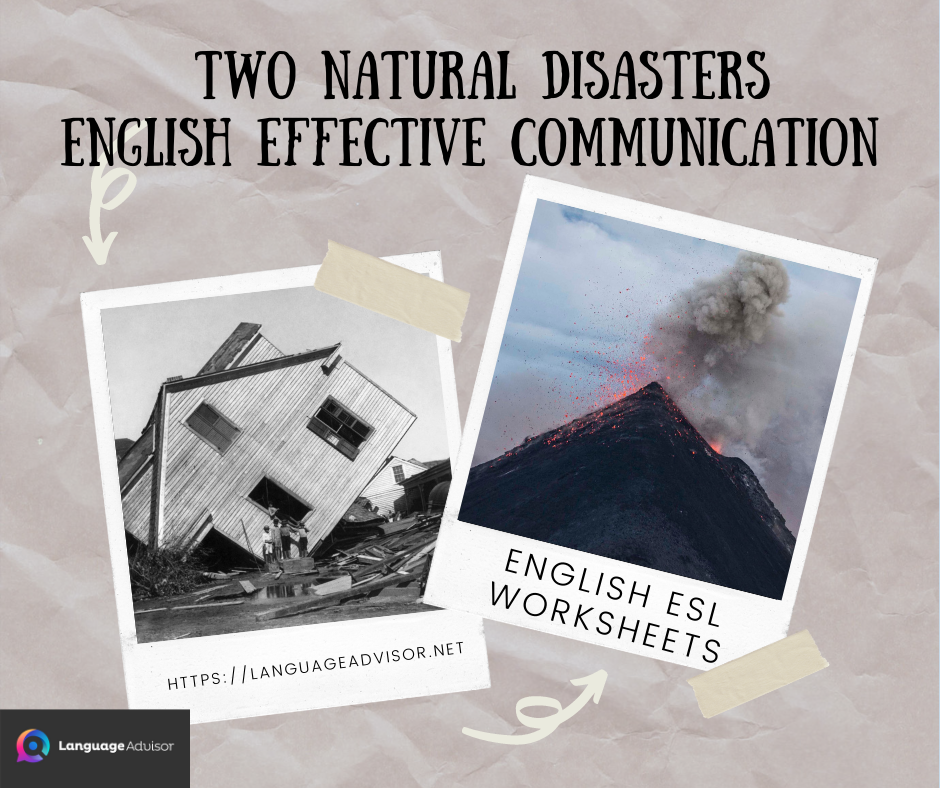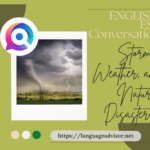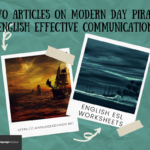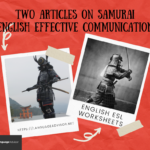Two Natural Disasters – English Effective Communication. English ESL Worksheets to improve reading and develop strong language and Speaking skills.
Two Natural Disasters – English Effective Communication

Two Natural Disasters – English Effective Communication
Procedure
Divide the class into pairs. Give each student a copy of either the A or B reading sheets. The students read the short articles silently by themselves and use a dictionary or consult the teacher if they don’t understand a word or phrase. After the students have read and understood the articles, the teacher takes the articles away. Then student A will communicate what was in A’s article to student B, and student B will communicate what was in B’s article to A. Then all of the students take a test to see how much information they were able to communicate.
| Earthquakes Humans may think they are the master of the world, but every now and then Nature lets the earth shake and reminds us who the real master is. When earthquakes hit, there is often no warning and the damage can be worse than a nuclear bomb. In 1976, an earthquake devastated Tangshan, China killing 255,000 people according to the official count. Unofficial counts put the death toll at 655,000. And that earthquake may not have been the biggest in history; In 1556, an earthquake hit China which may have killed over 800,000 people. When the earthquake hits, that is often just the beginning of the disaster. Even after the ground stops shaking, the disaster is not over. Fires caused by the earthquake, appear all over the affected area. And because many of the water pipes are broken, there is no way to stop the fire from spreading. Fire destroyed most of San Francisco when an earthquake hit in 1906. But fire is not the only calamity that can happen after an earthquake; Disease can take a deadly toll. Since earthquakes often destroy sanitation and water systems, people are left without clean drinking water. Without clean water, cholera and other diseases can cause an epidemic throughout the population. | Volcanic Eruptions In normal times, nature is our great benefactor: we get our food, our housing, and our energy from it. And then, at other times, nature is our greatest adversary: When hot magma forces its way to the surface of the earth, there is nothing we can do. Volcanic eruptions are deadly and unstoppable. When an Indonesian volcano, Krakatoa, erupted in 1883, it caused a massive tsunami that was 40 meters high. These waves destroyed 165 coastal villages, killing over 36,000 people. Ash from the eruption turned the sunsets red for many years after. When Pelee, a volcano in the West Indies, erupted in 1902, it sent a massive cloud of poisonous gas down into the city of St Pierre. This cloud of gas traveled at a speed of 100 km/h and within three minutes it suffocated the 30,000 inhabitants of St. Pierre. There was only one survivor in the whole city: a prisoner in a dungeon who survived in his cell for four days buried under the ash. One ship that was in the harbor of St. Pierre managed to barely escape. Most of the crew was dead or dying on the scorched ship when it arrived at another port in the West Indies. A port official asked the ship where it came from. The ship’s captain replied, “From the gates of hell.” |
Two Natural Disasters
| (1) What is the title of the article? (2) According to the article, what do humans think they are? (3) What are earthquakes more deadly than? (4) Where did earthquakes occur in 1976 and 1556? (5) In 1976, what was the official death toll? (6) In 1976, what was the unofficial death toll? (7) In 1556, how many people may have been killed? (8) What other disaster often follows an earthquake? (9) Why is it difficult to stop the fire from spreading? (10) What city was destroyed by fire in 1906? (11) Other than fire, what is another calamity that often occurs after an earthquake? (12) Why do epidemics sometimes occur after an earthquake? | (1) What is the title of the article? (2) What is nature in normal times? (3) What is nature at other times? (4) What can we do when hot magma comes to the surface? (5) What did the volcanic eruption on Krakatoa cause? (6) How many villages were destroyed? (7) How many people were killed? (8) What did the volcanic eruption of Pelee send down into the city of St. Pierre? (9) How fast did the gas travel? (10) How fast did the people die? (11) How many survivors were there? (12) Where was the lone survivor? (13) What escaped from the harbor? (14) Where did the captain say that the ship had come from? |

All downloads are in PDF format
DOWNLOAD THE PDF FOR FREE







